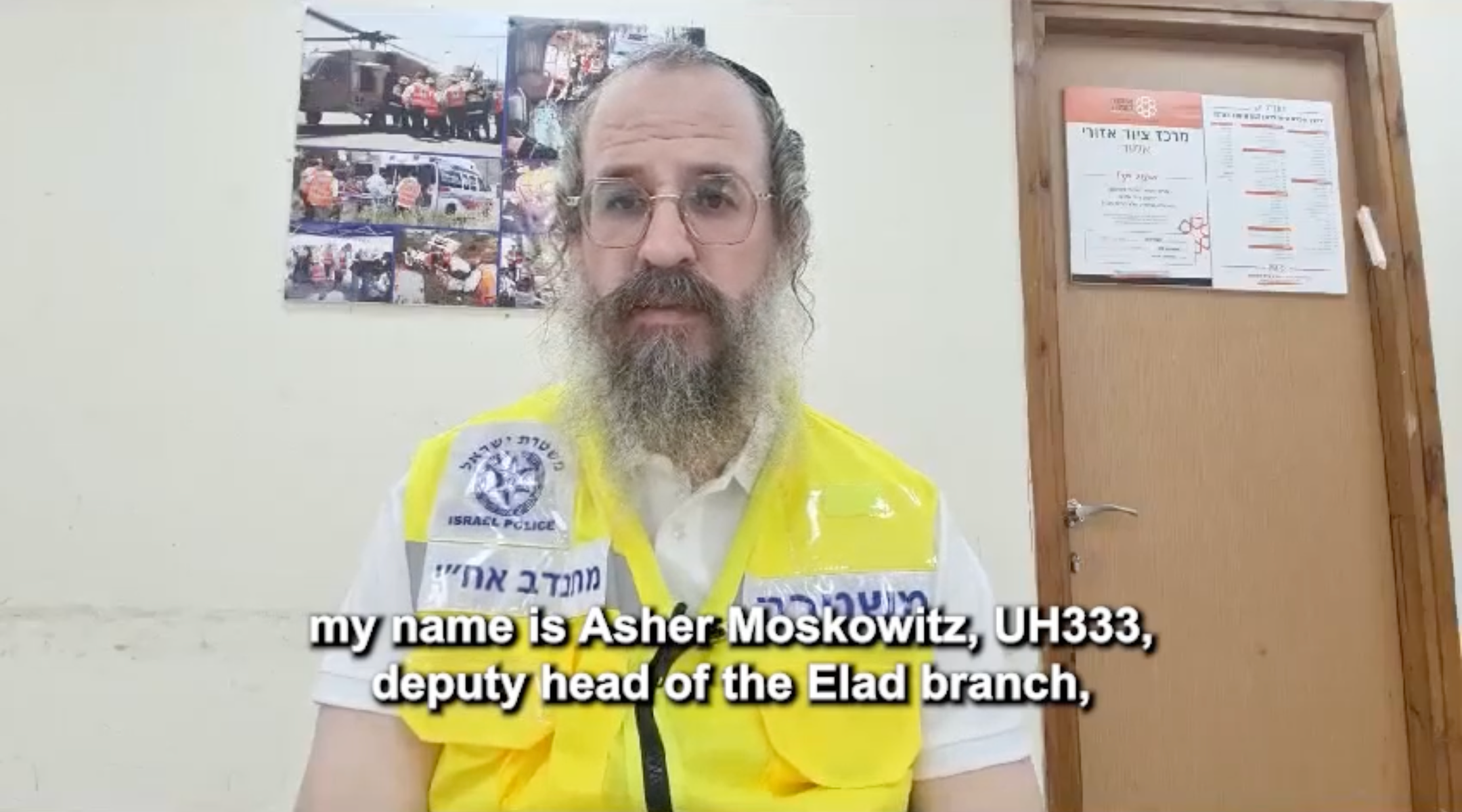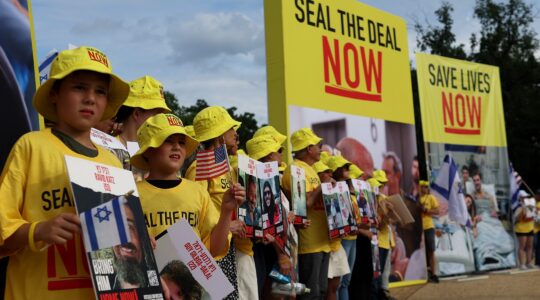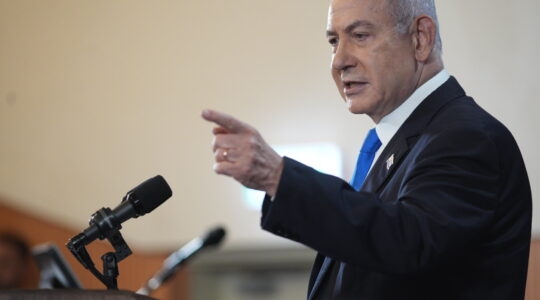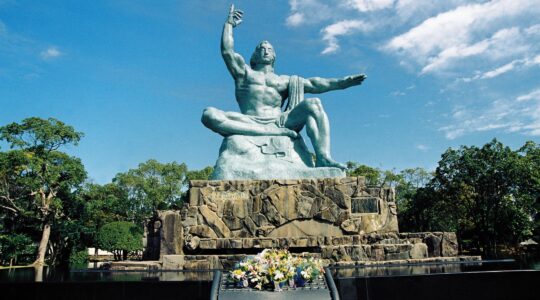An update has been appended to the end of this story concerning a Dec. 3 Haaretz report that cast doubt on the details of this account.
(JTA) — It was on the fourth day of the war between Israel and Hamas, Asher Moskowitz recalled, that he saw the baby among the corpses at Camp Shura.
Moskowitz had come to Shura, a military base near the central Israeli city of Ramle, as a volunteer with the United Hatzalah emergency response corps. The base had been transformed into a center for identifying those killed in the Oct. 7 massacre by Hamas, the terror group that controls Gaza, and Moskowitz was soon pulled into the gruesome task of helping to unload and transfer dozens of bodies that arrived there.
The baby came from Kibbutz Kfar Aza, one of the communities hardest hit in the attack. It arrived in a small bag whose contents told a grim story: a tiny body, burnt and swollen, with the telltale marks from being pressed against a heating element.
“They took the baby and put it, literally, in a kitchen oven,” Moskowitz said in a video testimony recounting the assessment of professional staff at the base.
The video was recorded at Hatzalah’s request to preserve a firsthand account of what Moskowitz saw, and it was shared with the Jewish Telegraphic Agency on Tuesday. The video, one of several recordings of Hatzalah volunteers describing what they saw, had not been made public as of Tuesday afternoon.
“The body hardened and, unfortunately, appeared to have also swollen,” he said. “And really, the heating element of the oven was on the body itself.”
The list of atrocities that has emerged from Hamas’ Oct. 7 attack on Israel is so long as to feel endless. First responders and survivors have related stories of burnt bodies, of people tied up and murdered, of partygoers gunned down en masse at a music festival.
But the story of the baby burnt in an oven has attracted particular attention this week for a number of reasons, in addition to the tender age of the victim. The presence of an oven evokes the horrors of the Holocaust in graphic terms, creating a link between the antisemitic genocide of 80 years ago and Oct. 7, which was the bloodiest day for Jews since then.
The story has also drawn attention because it was shared publicly for the first time when Hatzalah’s founder and president spoke at an American political convention in Las Vegas.
“We saw a little baby in an oven,” Eli Beer, the founder and president of Hatzalah, said in a speech to the Republican Jewish Coalition’s annual conference on Saturday night.
As the story spread on social media, some responded with shock that there were yet more revelations to come about atrocities committed on Oct. 7. At least one prominent Palestinian voice drew condemnation for responding with a joke. And a few people wondered aloud whether the story was true, given that it had not previously been reported.
The Israeli government has been engaged in efforts to head off or refute claims that the massacre and its attendant atrocities were fabricated or exaggerated. In the days after the massacre, Israel invited foreign journalists to tour Kfar Aza and other ravaged communities, and last week, it showed them 43 minutes of raw footage from Oct. 7 to counter what a government spokesperson called “a Holocaust denial-like phenomenon evolving in real time.”
Beer said he’s aware that people are denying that the atrocities took place, or are casting doubt on their scale — something he considers akin to Holocaust denial given the depth and breadth of evidence. But he said he had “not at all” worried about people denying this story because of the time that had elapsed since Oct. 7.
“I wasn’t concerned,” he said. “I don’t understand why people think this is the worst. This is not even the worst. Why is an oven the worst? Why is [it] not murdering children in front of their parents?”
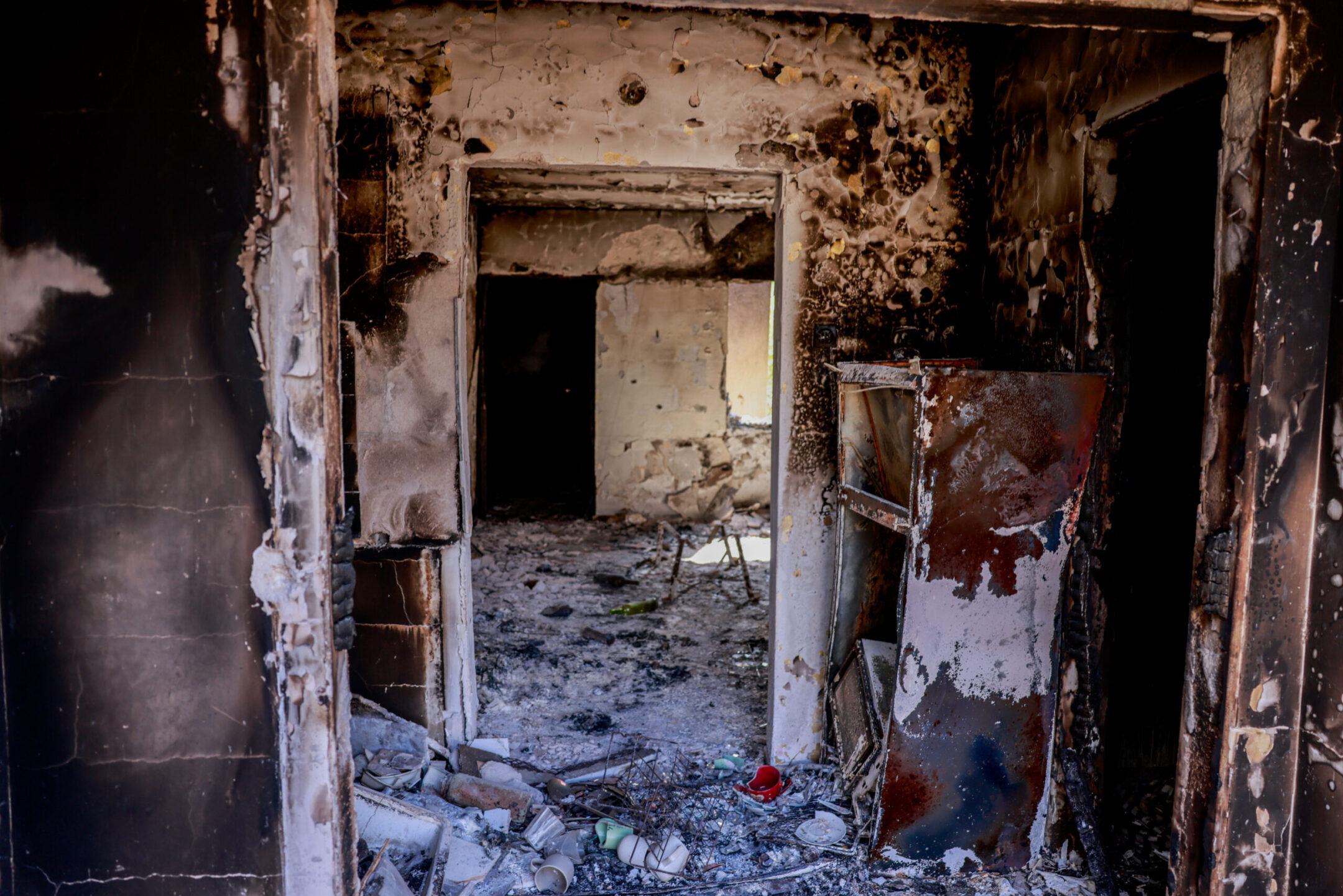
Destruction caused by Hamas in Kibbutz Kfar Aza, near the Israeli-Gaza border, in southern Israel, Oct. 10, 2023. (Chaim Goldberg/Flash90)
Speaking to JTA on Tuesday, Beer said he learned of the atrocity from at least two of his volunteers. He first heard of it soon after it occurred, from a volunteer who was on the scene on Oct. 8 when a team of first responders discovered the baby’s body, along with the bodies of the murdered parents. Moskowitz then called Beer “a day or two” after he saw the body at Shura.
That story was swirling in his head, Beer said, along with hundreds of others, as the days went by and more victims were identified. While that was happening, Beer continued his work with Hatzalah while under Hamas rocket fire. In addition, two Hatzalah volunteers were killed in Hamas’ attack, and many more are suffering post-traumatic stress, he said. His son is serving in the Israeli military.
Only on his trip to Las Vegas, Beer said, was he able to get a good night’s sleep and clear his head a bit. On the day of the speech, he thought of the story of the baby burned in an oven and decided to include it in his remarks.
“I said, you know what, I heard these stories, and people have to hear it,” he said. “And even so, it’s hard to believe that all these tragedies were happening. But it happened. All these bad things happened.”
There is still much that is unknown, and that may never be known, about the baby’s death — including, for now, the child’s name and age. The parents were killed alongside the baby, and the house was torched, Beer said. According to a Washington Post report on Tuesday, Israeli officials have yet to identify some 200 bodies because they were mutilated or burned.
That paucity of knowledge leads, Beer said, to a number of gruesome questions: Did Hamas terrorists put the baby in the oven, then kill the baby as they turned the oven on? Did the baby’s parents hide the child in the oven to keep them safe from the attackers, only to burn as the house was set aflame? When was the baby killed?
“They have many bodies that aren’t identified yet,” Beer said. “Luckily today there is technology that they can do DNA and everything, but what happens when the whole family are murdered?”
He added, “A lot of the stories will never be told because the people that saw it and witnessed it are not with us anymore.”
In his video testimony, Moskowitz also recognized the need to counter denial of the massacre’s horrors.
“In the context of these horrors we need to show the world and tell the world that it is impossible to deny what they did,” he said. “They raped women, they killed bodies, they killed living people. They amputated limbs, cut off heads — horrors that have already been seen. But this is a horror that we must tell the world.”
UPDATE: A Dec. 3 article in Haaretz cast doubt on the details of this account, specifically reporting that no babies were reported killed in Kfar Aza and that the Israel Police have no record of a baby having been killed in this manner. According to Haaretz as well as the Israeli publication Ynet, only one baby has been confirmed to have been killed during the massacre, at Kibbutz Be’eri, in addition to a baby born of a wounded mother on Oct. 7 who died in the first hours of life.
The Haaretz article did not reference Moskowitz’s video testimony, and Moskowitz told JTA on Dec. 5 that he has not read the Haaretz story and that he stands by the account he gave. He said he “certainly, no question” saw the burnt body. He said he saw the body for a period of a minute or two at Shura on Monday, Oct. 9 or Wednesday, Oct. 11. He said that he and other volunteers were told the bodies were coming from Kfar Aza, though it’s possible they came from another location. He said he saw “a small body. The body was black and was calcified.” He added that it was “possible” that the body was of “a certain age” other than infancy.
